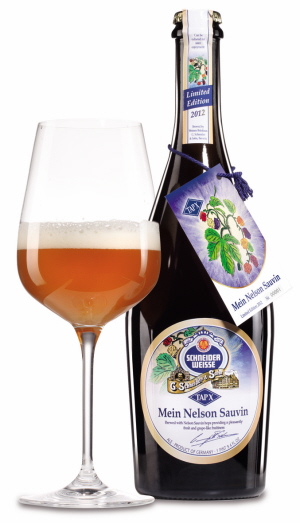
Schneider Weisse Tap X Mein Nelson Sauvin.
ABV: 7.3%
Origin: Kelheim, Bayern, Germany
Website: www.schneider-weisse.de
Of all the great European brewing industries, Germany’s seems the most conservative, complacent and insulated from international trends. Many of the country’s vast numbers of brewers still seem to think no further than their immediate distribution area, whether that’s a region or a village, with little recognition that the world at large is interested in their traditional beers, let alone that brewers beyond that area might have the occasional good new idea from time to time.
In an era where brewing is becoming increasingly globalised, and polarised between an innovative and dynamic craft sector on the one hand and a blanded out, marketing driven mainstream dominated by aggressive multinationals on the other, it’s an attitude that doesn’t bode well for Germany’s much-prized focus on quality.
Thankfully there are some shining examples of German brewers who’ve, so to speak, woken up and smelt the hops, and one of them is Schneider in Kelheim – possibly the most revered producer of traditional Bavarian weissbier.
The brewery hasn’t messed with any of its textbook brews, but it’s responded to interest in export markets by stretching the boundaries of the style with a series of occasional specials, devised by head brewer Peter Drexler and chief executive Georg Schneider VI. All Schneider’s regular brews are now giving “tap” numbers – for example its legendary dark Weissbock Aventinus is designated Tap 6 – and the new beers are pegged as Tap X.
The first experiment was prompted by a request from ABT (Alliantie van Bier Tapperijen), the Dutch association of specialist beer pubs, for a special to celebrate its 25th anniversary in 2011. Far sightedly, the brewery focused on hops, creating a fine strong golden wheat beer which, remarkably for Germany, featured the New Zealand varieté du jour, Nelson Sauvin.
Tap X Mein Nelson Sauvin was a great success not only in ABT pubs but in the US and other export markets – and, interestingly, at home in Germany too. “Public taste has noticeably evolved,” observed Georg. So the beer made a return appearance in 2012, and I wouldn’t be surprised to see it again before long.
The use of an exotic hop has enabled the production of an innovative beer that still complies with traditional purity requirements, otherwise sticking to a grist of barley and wheat malt. One other unusual (and international) touch, though, is the use of a second yeast from Belgium for bottle conditioning.
I bought my elegant 750ml bottle of the 2012 version, number 7843, from Utobeer in Borough Market. It poured a deep and cloudy yellow with a typical thick and creamy wheat beer head. The aroma, though, wasn’t typical – although subtle, the grape and spice character of the hop was evident alongside a slightly tannic note and the more accustomed Weissbier whiffs of cream and banana.
A very intriguing creamy, spicy and fruity palate had more grape notes – muscat rather than sauvignon blanc – and spicy tangerine flavours. The apple, apricot and grape finish had building bitter notes, with more hop bitterness than is usual in the style, finishing with plenty of creamy cereal and seedy, spicy tones.
It’s not only an excellent beer, but a fine example of how a great historic brewery with deeply rooted traditions can respond to those evolving tastes without chucking out what made it great in the first place.
For a brief note on the history of the brewery see my 2007 review of Schneider Weisse.





Leave a Reply